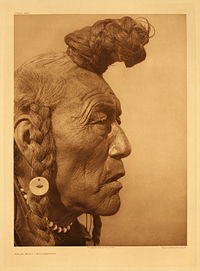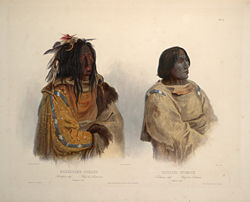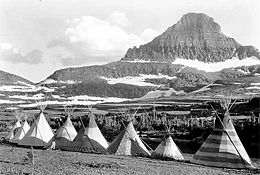Blackfoot
| Blackfoot |
|---|
 |
| Total population |
|
32,000 |
| Regions with significant populations |
( ( |
| Languages |
| English, Blackfoot |
| Religion |
| Christianity, Traditional beliefs, other |
| Related ethnic groups |
| other Algonquian peoples |


The Blackfoot Confederacy or Niitsítapi (meaning "original people"; c.f. Ojibwe: Anishinaabeg and Quinnipiac: Eansketambawg) is the collective name of three First Nations in Alberta and one Native American tribe in Montana.
The Blackfoot Confederacy consists of the North Peigan (Aapátohsipikáni), the Blackfeet or South Piegan (Aamsskáápipikani), the Kainai Nation (Káínaa: "Blood"), and the Siksika Nation ("Blackfoot") or more correctly Siksikáwa ("Blackfoot people"). The South Peigan are located in Montana, and the other three are located in Alberta. Together they call themselves the Niitsítapi (the "Original People"). These groups shared a common language and culture, had treaties of mutual defense, and freely intermarried.
Contents |
History and culture
The Blackfoot were fiercely independent and very successful warriors whose territory stretched from the North Saskatchewan River along what is now Edmonton, Alberta in Canada, to the Yellowstone River of Montana, and from the Rocky Mountains and along the Saskatchewan River past Regina.
The basic social unit of the Blackfoot, above the family, was the band, varying from about 10 to 30 lodges, about 80 to 240 people. This size of group was large enough to defend against attack and to undertake small communal hunts, but was also small enough for flexibility. Each band consisted of a respected leader, possibly his brothers and parents, and others who need not be related. Since the band was defined by place of residence, rather than by kinship, a person was free to leave one band and join another, which tended to ameliorate leadership disputes. As well, should a band fall upon hard times, its members could split-up and join other bands. In practice, bands were constantly forming and breaking-up. The system maximized flexibility and was an ideal organization for a hunting people on the northwestern Great Plains.
During the summer the people assembled for tribal gatherings. In these large assemblies, warrior societies played an important role. Membership into these societies was based on brave acts and deeds.
Blackfoot people were nomadic, following the buffalo herds. For almost half the year in the long northern winter, the Blackfoot people lived in their winter camps along a wooded river valley perhaps a day's march apart, not moving camp unless food for the people and horses or firewood became depleted. Where there was adequate wood and game resources, some bands would camp together. During this part of the year, buffalo wintered in wooded areas where they were partially sheltered from storms and snow, which hampered their movements, making them easier prey. In spring the buffalo moved out onto the grasslands to forage on new spring growth. The Blackfoot did not follow immediately, for fear of late blizzards, but eventually resources such as dried food or game became depleted, and the bands would split up and begin to hunt the buffalo.
In mid-summer, when the Saskatoon berries ripened, the people regrouped for their major tribal ceremony, the Sun Dance. This was the only time of year when the entire tribe would assemble, and it served the social purpose of reinforcing the bonds between the various groups and reidentifying the individuals with the tribe. Communal buffalo hunts provided food and offerings of the bulls' tongues (a delicacy) for the ceremonies. After the Sun Dance, the people again separated to follow the buffalo.
In the fall, the people would gradually shift to their wintering areas and prepare the buffalo jumps and pounds. Several groups of people might join together at particularly good sites, such as Head-Smashed-In Buffalo Jump. As the buffalo were naturally driven into the area by the gradual late summer drying off of the open grasslands, the Blackfoot would carry out great communal buffalo kills and prepare dry meat and pemmican to last them through winter and other times when hunting was poor. At the end of the fall, the Blackfoot would move to their winter camps.
The Blackfoot maintained this traditional way of life based on hunting bison, until the near extinction of the bison by 1881 forced them to adapt their ways of life in response to the effects of the European settlers and their descendants. In the United States, they were restricted to land assigned in the Fort Laramie Treaty of 1851 and were later given a distinct reservation in the Sweetgrass Hills Treaty of 1887. In 1877, the Canadian Blackfoot signed Treaty 7 and settled on reserves in southern Alberta.

This began a period of great struggle and economic hardship; the Blackfoot had to try to adapt to a completely new way of life, as well as suffer exposure to many diseases their people had not previously encountered.
Eventually, they established a viable economy based on farming, ranching, and light industry, and their population has increased to about 16,000 in Canada and 15,000 in the U.S. today. With their new economic stability, the Blackfoot have been free to adapt their culture and traditions to their new circumstances, renewing their connection to their ancient roots.
Enemies
The Blackfoot were enemies of the Crow and Sioux (Dakota, Lakota, and Nakota) on the Great Plains; and the Shoshone, Flathead, and Kootenai in the mountain country to their west. Blackfoot war parties would ride hundreds of miles on raids. A boy on his first war party was given a silly or derogatory name. But after he had stolen his first horse or killed an enemy, he was given a name to honor him.
Notable Blackfoot descendants
- Ananda Lewis, American TV/talk show host.
- Sole, rapper and wife of artist Ginuwine
- Mykelti Williamson, actor notable for portraying Bubba in the 1994 film Forrest Gump.
- Nick Carter & Aaron Carter, pop singers[1]
- Tyson Tomko, a professional wrestler, has prominent tattoos scaling the upper-part of his body for his Blackfoot heritage.
- Kiri Davis, noted youth filmmaker and director of A Girl Like Me.
- Jonathan Brewer, Blood Tribe member and actor notable for playing Blunted in Apocalypto.
- Blackie Lawless, the lead singer of the rock band W.A.S.P.
- Rickey Medlocke, lead singer/guitarist of Blackfoot.
- Jewel Blackfeather, American writer and performance artist[2].
See also
- Blackfoot music
- Piegan Blackfeet
Notes
- ↑ Barnes, Corey (1999). Backstreet Brother: Aaron Carter. New York: Random House. pp. 88. ISBN0-375-80193-6. http://www.amazon.com/dp/0375801936/.
- ↑
- though not a Blackfoot himself, Screamin' Jay Hawkins claimed to have been adopted and raised by the tribe as a small boy.
External links
|
|||||